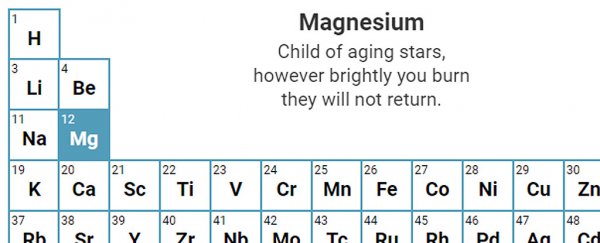Poetry probably wasn't the first thing to come to mind when you were trying to cram all the periodic table elements into your brain during school.
But science and poetry can be perfect allies, and we are totally blown away by the beauty of a new interactive period table, where each element gets its own little haiku.
Drawing from a range of fields, including astronomy, biology, and history, the Elemental haiku comprises 119 science poems, arranged in the classic periodic table structure that we all know so well.
Many of the poems are superbly clever allusions to how each element operates in the natural world. Like this poetic take on the role sodium plays in our nervous system:
Sodium
Racing to trigger
every kiss, every kind act;
behind every thought.
The masterpiece, published online with the August issue of the journal Science, is the work of British speculative fiction author Mary Soon Lee, whose stories and poems have collected many awards over the years.
"I wrote the first couple of haiku (Hydrogen and Helium) on a whim, and then decided to see whether I could make it all the way to the end of the periodic table," Lee told ScienceAlert.
It took her about four months of daily poetry writing to accomplish the feat, sometimes labouring over a poem for several hours.
Lee actually has a background in space engineering and computer science, but, like most of us, her last brush with chemistry was at high school, so this writing project required a lot of research.
"I researched almost every element, though sometimes I ended up writing something whimsical instead or drawing on information I'd already known," said Lee.
Like this somewhat amusing take on radon, the cancer-causing radioactive gas known to be a hazard in some US homes:
Radon
Homeowners' hazard,
skulking down in the basement,
plotting your decay.
Apparently, this is not even the first time a haiku elemental table has been created, although it's the only one we know of that's been authored by just one poet.
To check out all 119 poems, head over to the interactive and simply click or tap on each element to read its corresponding haiku.
